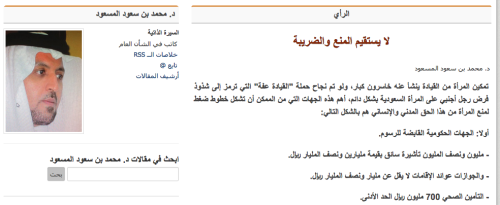One of the biggest misconceptions about Saudi Arabia is that the ban on women driving is societal. As a matter of fact, women driving is only prohibited in the cities. In traditional rural areas, women drive with no objections by society or government. If tribes living their traditional lifestyles in their villages have no objection to women driving, why would their more modern urban counterparts object? The answer is they don’t either. Women and men across the country have defied the ban either by driving or speaking out with no societal consequences but rather governmental. People have been suspended from their jobs, imprisoned and banned from travel simply for wanting the ban lifted. There is no definite answer as to why the government will not allow each woman to choose for herself whether or not to drive. However, there have been a few analyses as to why the ban is so strictly implemented. One of these is this article by Dr. Mohammed bin Saud AlMasoud published in Aleqtisadiah Newspaper on 19/July/2014. Here I’ve translated it for everyone:

Lifting the ban on women driving will result in big losses for many. The
Lifting the ban on women driving will result in big losses for many. The campaign Women Driving is More Chaste addresses the abnormality of permanently imposing a strange man on Saudi women. The success of this campaign will be challenged by three institutions. These institutions will most likely constitute pressure lines to prevent women from obtaining the human and civil right of driving their own cars.
First: Fee-charging government bodies
– One and a half million drivers’ visas worth two and a half billion SAR (six hundred sixty-six million USD).
– The General Passports Department earns one and a half billion SAR (four hundred million USD) from residency fees.
– Health insurance fees bring in a minimum of seven hundred million SAR (a hundred eighty-six million USD).
Thus, the Interior Ministry will lose approximately five billion SAR (a billion and three hundred thirty-three million USD) if women driving were to be legalized. These enormous returns will start to dwindle and fall until ultimately they become nothing. It’s no wonder that the Interior Ministry is not overly enthusiastic about the idea of lifting the ban and are firm and strong against women who attempt to exercise their right to drive.
Second: Taxi companies
The vast majority of this companies are owned by elites. 85% of their business depends on women seeking transportation in the bigger cities. These businesses generate unbelievably huge sums that reach to five million SAR (a million and three hundred thousand USD) a month. Naturally, if women were allowed to drive, this enormous financial resource will gradually dry up. Hence those millions a month will be no more. Again, it’s no surprise that these elites would not be too excited or happy to see the ban lifted. This is what happen in Qatar when they lifted the ban on Qatari women driving. The taxi companies’ profits fell to a quarter of what they were. It is especially worrying for the Saudi companies now that taxi charges rose a 100% in the cities after fees on foreign recruitment rose.
Third: Recruitment agencies and airlines
When we talk about one and a half million visas then we are also saying one and a half million flights worth up to three billion SAR (eight hundred million USD), as well as one and a half million recruitment contracts valued at eight billion SAR (two billion USD) minimum. The price of recruiting one driver from abroad is about eight thousand SAR (two thousand USD) which adds up to thirteen billion SAR (three and a half billion USD). That is a number that would be difficult to let go. Experts are forecasting that under the current ban the number of drivers is expected to double to three million foreign drivers. Thus, these profits will also increase a 100%.
All the billions mentioned above are paid by Saudi families and specifically Saudi women, not once but many times over. What’s more, financial penalties up to twice the original cost are imposed if there is any delay in payment. For example, the driver’s residency renewal fees double if they are not paid on time.
Hence, we have so many winners at the expense of Saudi women. Women, who are weak, tender, helpless citizens in need of protection and care, represent 60% of humanity’s workforce, and yet women have to bear all these consequences. Since the ban on women driving is implemented with threats of firmness and strength against all who defy it, it would only be fair to revise all these driver recruitment fees and fines. These fees add up to about six billion SAR (one and a half billion USD) paid by Saudi families, in particular, Saudi women because drivers are imposed on them by necessity.
No comments:
Post a Comment